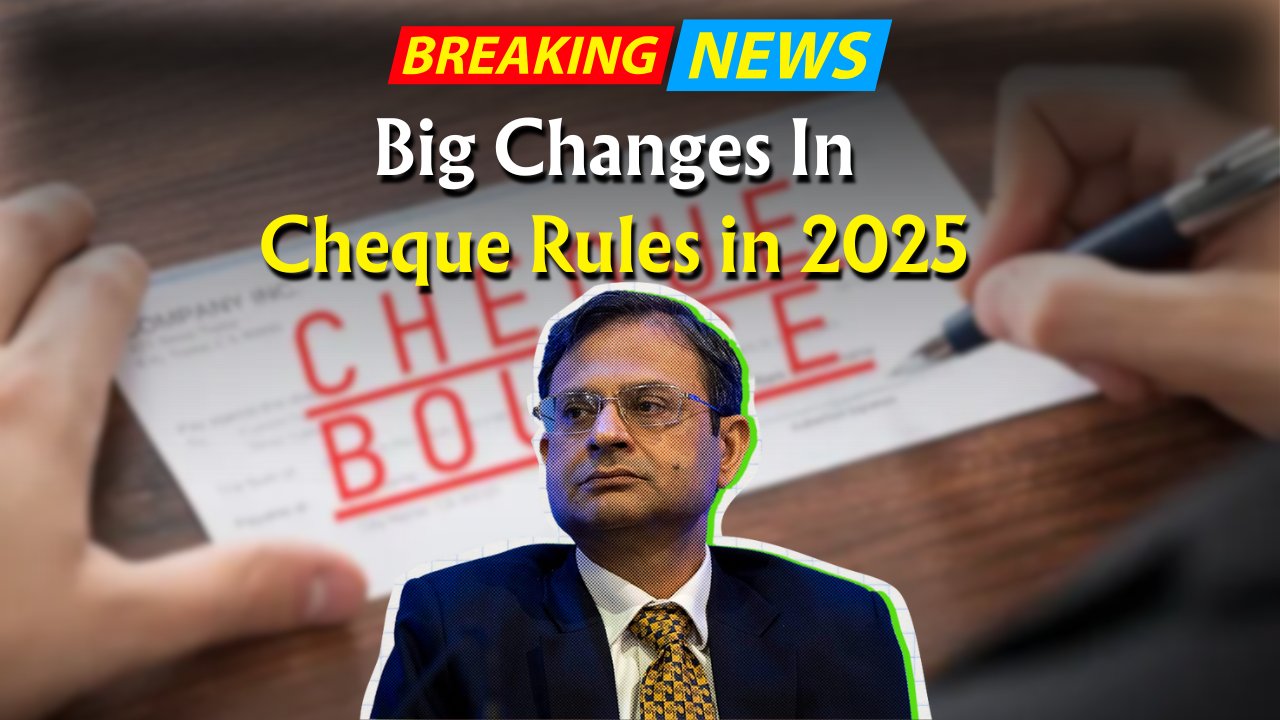Cheque Bounce Rules – The Reserve Bank of India (RBI) and Indian courts have introduced stricter rules and clearer enforcement mechanisms for cheque bounce cases starting in 2025. These reforms aim to curb the rising number of dishonoured cheques and streamline the legal process for both individuals and businesses. This article provides a full breakdown of the updated rules, penalties, and steps you must take to avoid complications.
What is a Cheque Bounce Rules?
Cheque bounce rules govern the legal action taken when a cheque is dishonoured due to issues like insufficient funds or signature mismatch. Under Section 138 of the Negotiable Instruments Act, 1881, the issuer can face fines or jail. In 2025, stricter penalties and faster digital procedures have been introduced for quicker resolution. A cheque bounce occurs when a cheque presented to the bank cannot be processed due to insufficient funds, incorrect details, account closure, or signature mismatch. It is a criminal offense under Section 138 of the Negotiable Instruments Act, 1881.
Key Changes in Cheque Bounce Rules 2025
The 2025 update introduces several critical changes designed to protect recipients and ensure prompt redressal:
- Stricter deadlines for cheque clearance and legal action.
- Heavier penalties for repeat offenders.
- Mandatory e-intimation to the drawer before initiating legal action.
- Digital tracking of cheque dishonour cases.
- Court priority for cheque-related complaints.
- Increased compensation to payees for inconvenience and financial loss.
- Faster resolution through special fast-track benches.
New Penalty Structure for Cheque Bounce Cases
Under the 2025 rules, first-time cheque bounce offenders face fines up to ₹25,000 or double the cheque amount. Repeat cases can lead to jail time. Companies may be fined up to ₹2 lakh, and daily penalties apply for delayed payments after notice.
Here is a table comparing the older penalties with the new revised penalties under the 2025 guidelines:
| Offense Type | Old Penalty | New Penalty (2025) |
|---|---|---|
| First-time Cheque Bounce | Fine up to ₹5,000 | Fine up to ₹25,000 or twice cheque amount |
| Second-time within 6 months | Fine + 1 year imprisonment (optional) | Fine + 1 year mandatory imprisonment |
| Repeated Offense (3rd time) | Civil case option | Criminal proceedings mandatory |
| Delay in payment post notice | No penalty | ₹500/day late fee after 15-day period |
| Corporate Cheque Bounce | Liability on company & signatory | Higher corporate penalties, ₹2 lakh cap |
| Failure to appear in court | Bailable warrant | Non-bailable warrant + license suspension |
| Compensation to Payee | Optional | Mandatory – 20% extra on cheque amount |
Legal Procedure After a Cheque Bounce Rules
The legal process in 2025 follows a stricter timeline and requires digital compliance:
- Cheque Bounces – Bank issues dishonour slip
- Within 15 Days – Payee must send e-notice to drawer
- Within 30 Days of Notice – Drawer must make payment
- If Unpaid – Case filed under Section 138 within 60 days
- Hearing Priority – Fast-track benches hear case within 90 days
- Judgment and Penalty – If guilty, penalties as per new guidelines apply
Steps to Avoid Cheque Bounce Penalties
Both cheque issuers and recipients must be proactive in managing cheques to avoid legal complications.
For Cheque Issuers:
- Maintain adequate balance in bank accounts
- Use e-cheque alerts to track payments
- Avoid issuing post-dated cheques without confirmation
- Ensure correct signature and details
- Stop cheque facility if not actively used
For Cheque Recipients:
- Deposit cheques promptly
- Track payment status using bank apps
- Keep digital proof of bounced cheques
- Follow new RBI e-notice format
- Consult legal counsel if payment isn’t made
Digital Tools Introduced in 2025
To strengthen traceability and transparency, the RBI has introduced tech-backed tools:
| Digital Tool | Purpose |
|---|---|
| e-Notice Portal | For legal intimation to drawer |
| Bounce Tracking Dashboard | Tracks dishonoured cheques across banks |
| Payee Compensation Form | Automatically calculates delay charges & payout |
| Fast-Track Case Numbering | Prioritizes cheque-related disputes in courts |
| e-Affidavit Upload | Digital affidavit submission to reduce paperwork |
How These Rules Help Businesses and Individuals
The updated rules benefit honest individuals and businesses by:
- Reducing court delays and unnecessary hearings
- Ensuring faster recoveries in case of dishonoured payments
- Deterring habitual defaulters with severe penalties
- Promoting digital compliance and documentation
- Increasing faith in cheque-based transactions
The cheque bounce rules for 2025 bring a much-needed overhaul to an outdated system. By introducing stricter penalties, tighter deadlines, and digital monitoring, the government and RBI aim to create a more transparent and efficient process for handling cheque-related offenses. To avoid legal hassles, both individuals and businesses must stay informed, follow compliance rules, and seek legal help promptly when needed.
FAQs about Cheque Bounce Rules
1. What is the minimum penalty for a cheque bounce in 2025?
The minimum penalty is a fine of ₹25,000 or twice the cheque amount, whichever is higher.
2. How long do I have to send a legal notice after a cheque bounces?
You must send a digital or physical notice within 15 days of receiving the dishonour slip.
3. Can I go to jail for a bounced cheque?
Yes, under the new rules, repeated cheque bounces can lead to mandatory imprisonment up to 1 year.
4. Is digital notice mandatory before filing a case?
Yes, the 2025 rules make e-intimation to the drawer compulsory before legal proceedings.
5. What happens if a company issues a bounced cheque?
Both the company and the authorized signatory are liable. Penalties can go up to ₹2 lakh, and criminal cases may follow.
